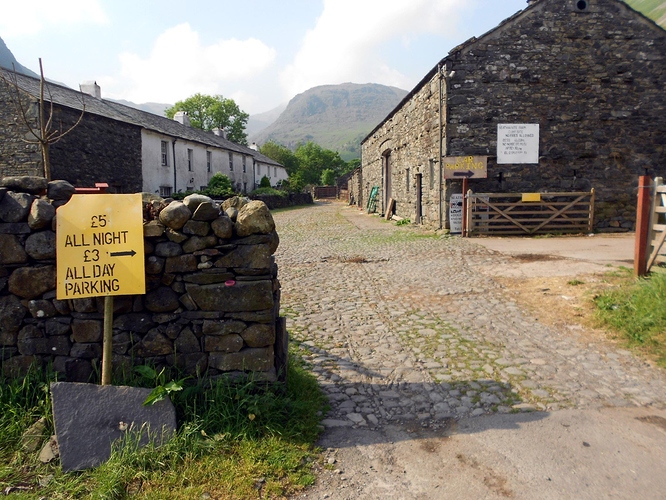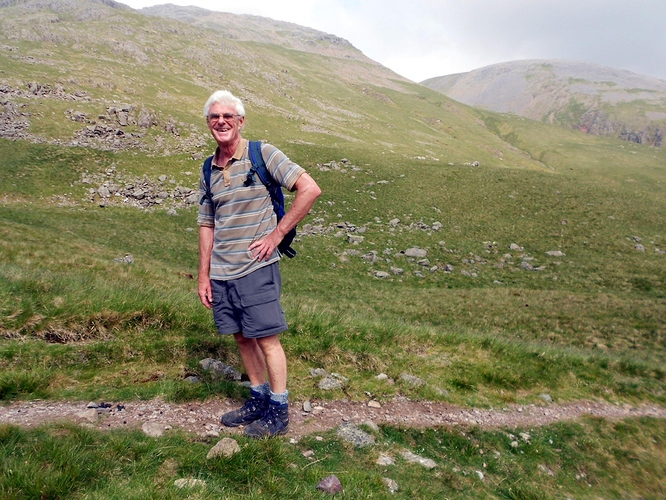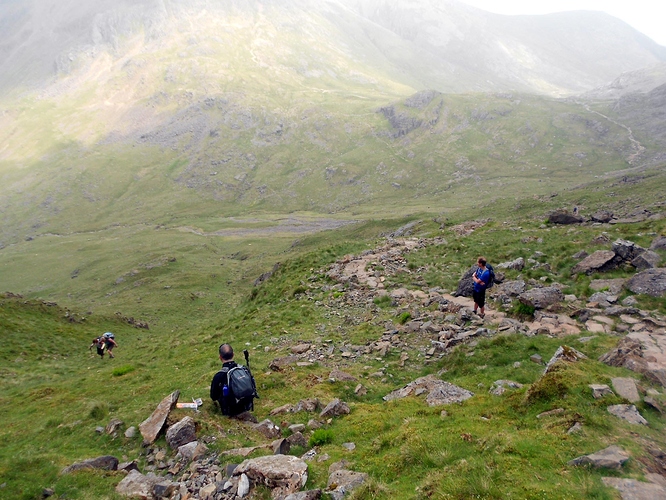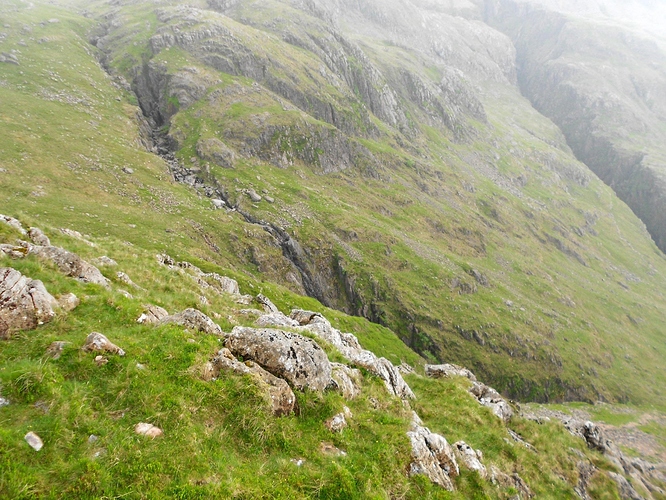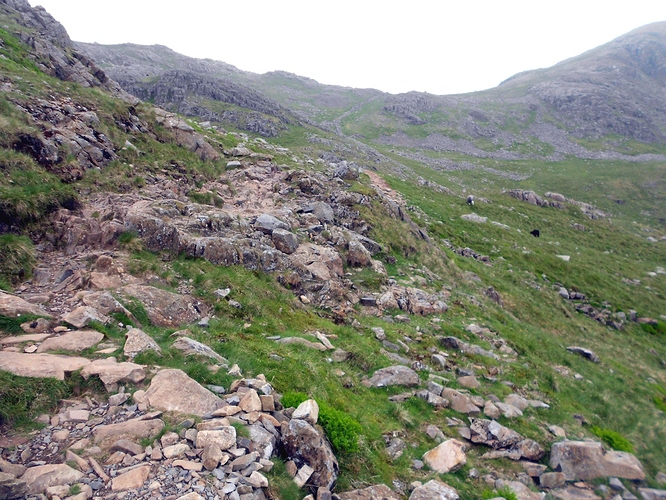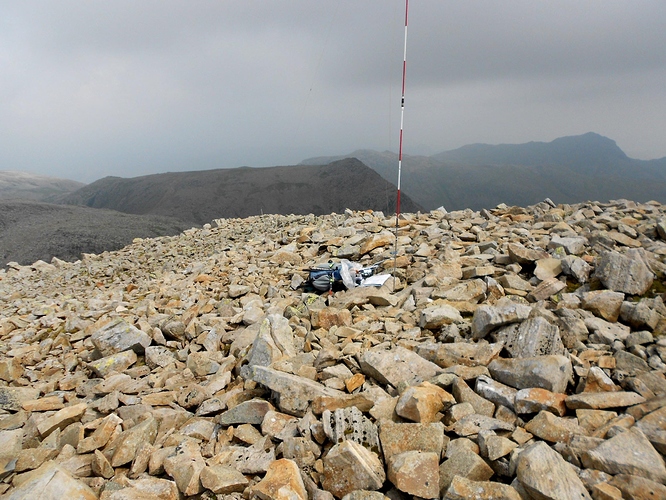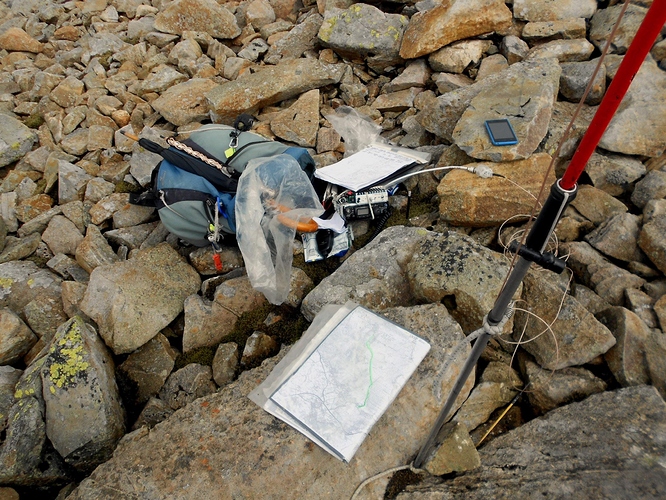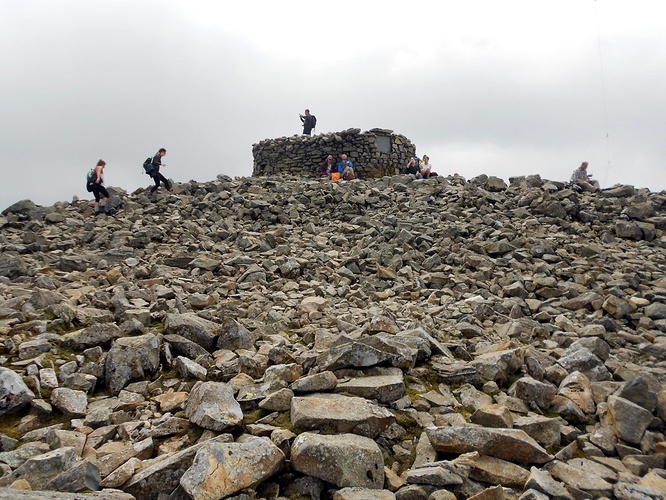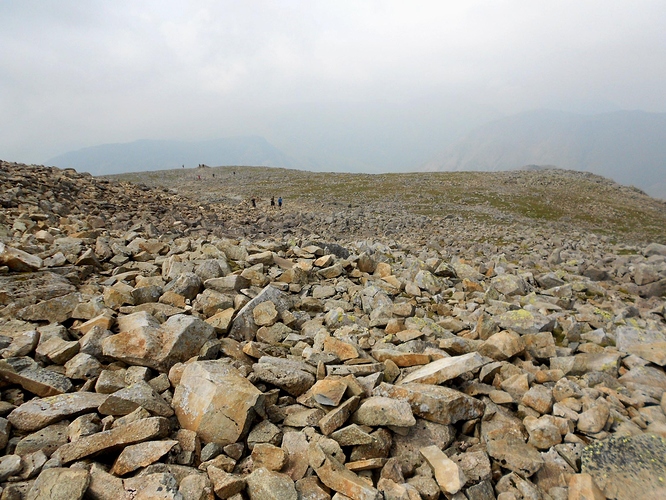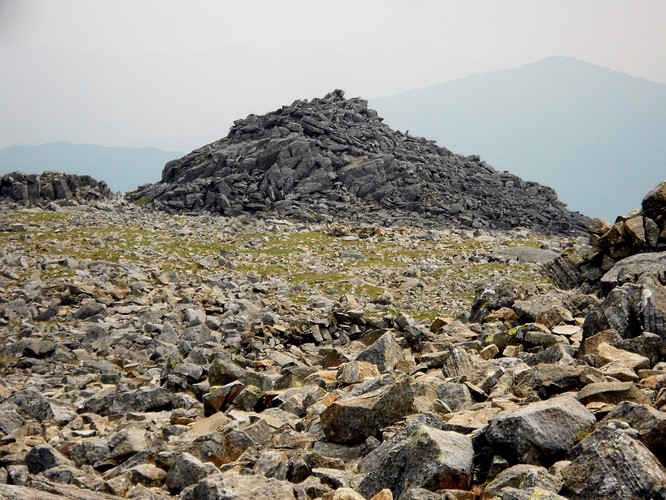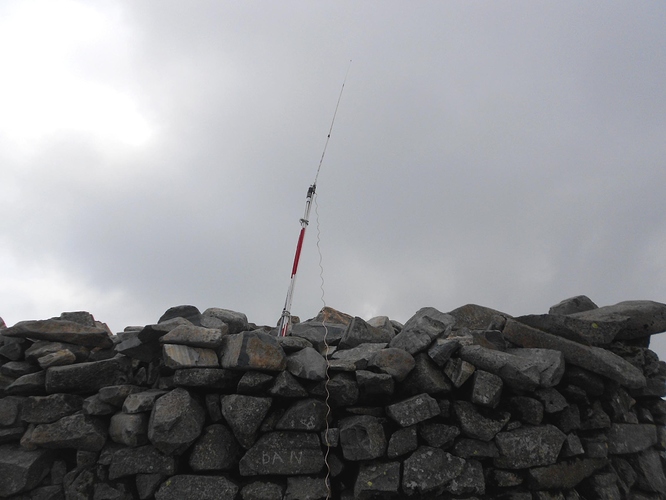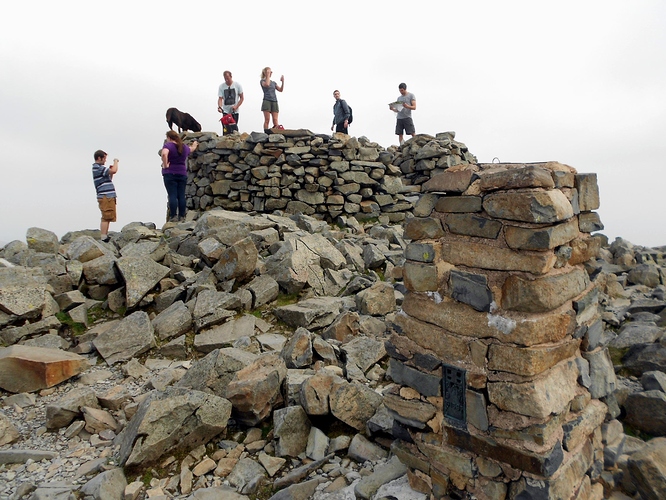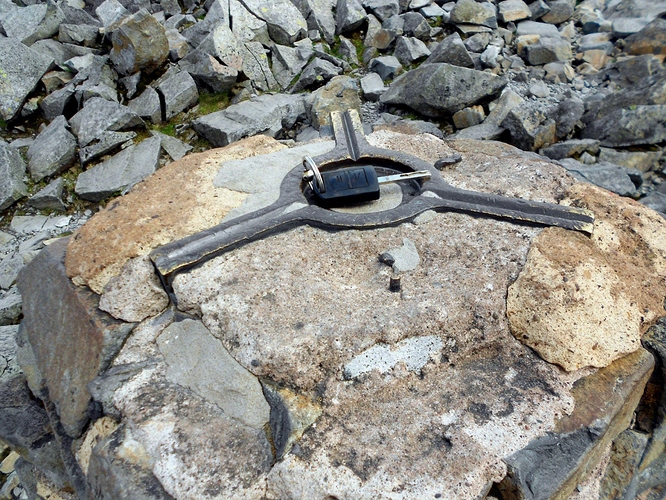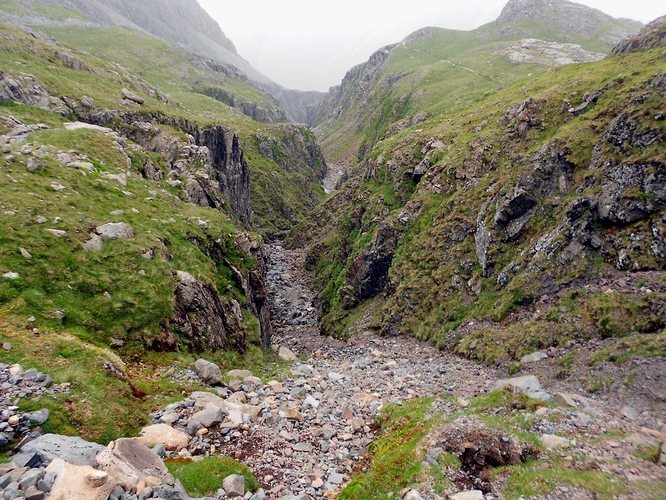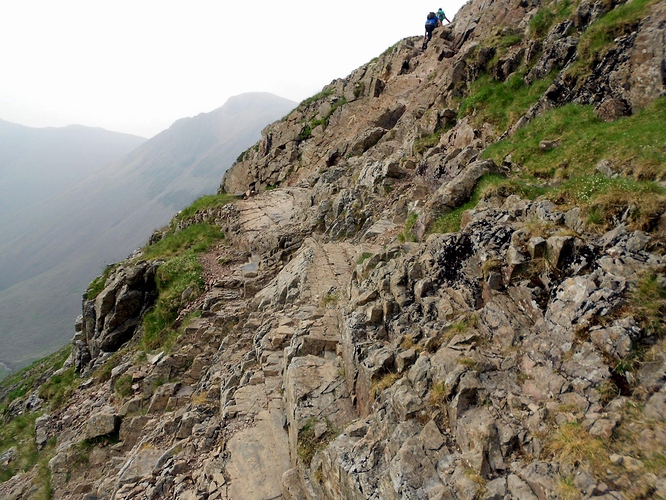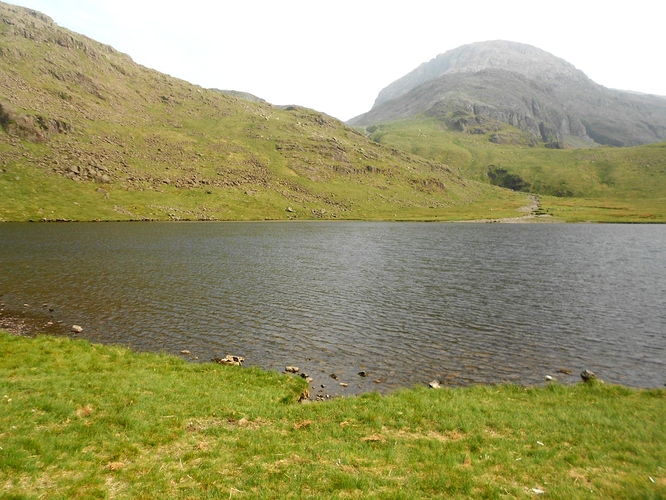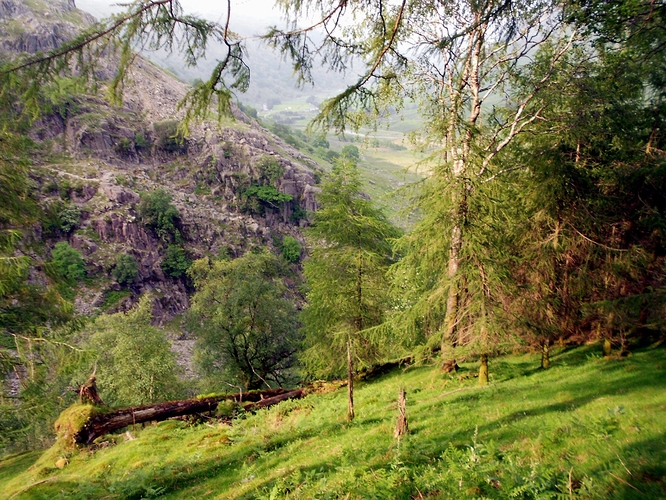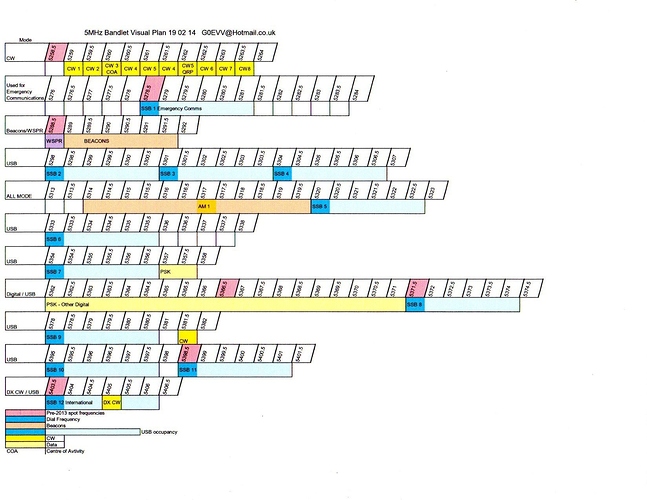G4YSS Activation Report for G/LD-001 - Scafell Pike on 9th June 2016
LAKES WEEK-2016:
This was day-5 of our annual five-night break in the Lake District with the walking group.
(G/LD’s: Day-1 LD20; Day-2 LD23; Day-3 LD4; Day-4 LD8; Day-5 LD1)
See: G4YSS: Lakes Week 2016, G/LD20-LD23-LD4-LD8-LD1 Report Links
G/LD-001, SCAFELL PIKE on 160-80-60-30-2-4m
G4YSS using GX0OOO/P (G4YSS/P on 5MHz)
QRO on 80m & 160m-CW/SSB; 60m-SSB and 30m-CW
QRP on 2m-FM & 4m-FM
All times BST (UTC + 1) UOS
Unaccompanied
EQUIPMENT:
FT817ND HF/VHF/UHF 5W Transceiver without internal batteries
MX-P50M 50 Watt HF Linear Amplifier
IC-E90 4-Band, 5W, V/UHF H/H for 2m-FM and 4m-FM
Antenna - HF:
Link dipole for 80-60-40-(30)-20m
Home-Brew tunable loading coils for 160m
Four section, 5m CFC mast with 1m end sticks
Li-Po Battery for HF: 11.1 V nom, 5Ah Turnigy (no reserve)
Antenna - VHF:
Half-wave vertical J-Pole for 2m-FM
Extended set-top helical for 4m-FM
QRO Packweight: 11.2 kg including large umbrella, 1 litre of water & fleece with contents.
INTRO:
Our walk leader David, incapacitated following a fall earlier in the week, was now going through the ‘gets worse before it gets better’ process with bruising, swelling and discoloured toes. He was booked in with an RAC breakdown truck that morning which would take him and his car all the way home to Worthing, a journey of 360 miles. Ruth and Roger had returned home the previous day and Rob was having back twinges. That just left me from the walking team so today’s target of Scafell Pike at the top of England was decided upon without feelings of regret.
It was another fine day in Keswick and the mountain forecast was for little if any rain, 14C at 750m ASL and light winds. In my opinion LD1 is best done from Seathwaite, particularly if you are staying in Keswick. Driving right around to Wasdale is very time consuming and as the ascent time is about the same despite a shorter distance, nothing is gained.
With HF conditions as they were, I only had to chose between two modus operandi. I could pack a handheld and just do 2m-FM or go for the harder option of HF with power. The latter would entail carrying a fairly heavy pack the five or so miles just to get up there but devil-may-care, I had ‘trained’ for this all week on lesser peaks. The most significant thing against me was the hot weather but aside from hydrating well, there was little I could do about that. The third option was to take the FT817ND and use it with 5 Watts but that’s only a good choice when HF conditions are above average.
With the chance of thundery rain, an umbrella was going with me but only the lightest one I had (355gm). I took out the IC-E90 6-4-2-70 Handheld, then put it back in again. I was not going all that way to get a fault on the HF gear with no backup. The Top Band loading coils were left in the rucksack. It’s a while since LD1 was offered on that particular band. Warm summit temperatures eliminated the need for a light mountain jacket that I am in the habit of taking when it’s cold. That wouldn’t make much difference to the pack weight however; I would have to carry the fleece that would have been worn on a cold day.
When compared with the alternative Esk Hause route there’s not a lot in it, so I chose Corridor up Corridor down. That way I could turn right and go to Great Gable instead if I started overheating more than expected.
Execution:
After running our leader David down to the sandwich shop, I bade him farewell, good luck and ‘get-well-soon.’ I was driving out of Keswick at 08:55. There were still parking spaces available at Seathwaite at 09:12 and they were not too far from the farm. Booting up and most other preparations had been done in Keswick so after forcing down 1.25 lites of water - yuk, I set off walking at 09:21.
In the warm muggy conditions I was fully aware that this was going to be a lengthy and unpleasant experience. Furthermore the distracter, an MP3 player refused to work but after 10 minutes I caught up with a chap of a similar age to me who was heading for Great Gable and possibly Kirk Fell. We passed some lads using huge rocks dropped by a helicopter, to mend the path just up from Stockley Bridge, walking together right the way up to Sty Head rescue box. The conversation was so interesting that I barely noticed the gradient or the temperature.
Coming from Bristol but originally Scottish, my newly found companion was a Munro compleatist of great experience so I was able to get advice on a number of GM summits I have yet to attempt and we compared experiences on some others that we’d both done. Just before 10:30, we parted at Sty Head but we didn’t cross paths on the way down.
A new GPS waypoint (NY 22088 09045) avoided my repeated error of loosing the path in the corridor at a point where it turns abruptly left and uphill but I stopped to chat with a group of two couples who had done just that. They men were looking down at their women who were scrambling up a grass bank; one which I know only too intimately.
Just before 11am, I was at the rock scramble which was dry and easy today but the rest was just a head-swimming blur of increasing unpleasantness and fatigue. The heavy load created a nagging ache in my right shoulder which couldn’t be relieved in any position. The dripping was incessant so it was fortunate that I’d sunk so much water before setting out. At the top of the Corridor where you turn right for the summit, a light cooling breeze started. This was more than welcome but by the time I reached the summit 25 minutes later, the breeze had gone.
Setting up:
Setting up the dipole is always a difficult job on a summit like LD1 with its loose rocks but after a few photos, I once again chose to put it a few metres down the NE slope from the big summit cairn. To avoid snagging, a modified technique is required on this kind of surface. The dipole is on a reel. Once the mast is assembled, with the coax unrolled and the dipole centre clipped on, I unroll the two wire legs and fix one of them to its end stick. Here’s where the process is different. On grass I simply walk the other leg back past the mast and anchor it to its end stick. On rock it is necessary to roll it back onto the reel then roll it off again when you get to the other side of the mast. That way it need never touch the ground and it’s well worth the extra time taken.
I found a more or less horizontal rock to sit on which was both large enough and sufficiently raised above its surroundings. The mast went into a hole between lesser rocks behind it.
SCAFELL PIKE, LD-001, 978m, 10 pts, 11:50 to 16:13. 18 deg C. 1 mph wind. Lightly overcast with hazy sunshine and intermittent thin low-cloud. No rain. IO84JK – NY20. Occasional Orange (EE) mobile coverage on the phone’s ‘S’ meter but little in practice.
3.557 CW - 1 QSO:
When I needed it, the phone was utterly useless so I was hoping I would be able to make contact (pre-arranged) with Roy G4SSH on here. Several calls over a period of 10 minutes produced nothing. That was probably down to it being midday conditions. Eventually Rob G4RQJ, closer at hand in Walney Island which would be line-of-sight, worked me with 599 both ways. I found out afterwards that Rob spotted me but I was off to SSB probably before that spot had chance to work. I did try a CQ or two but nil heard.
3.724 SSB - 7 QSO’s:
All stations were from the UK including some WAB members. Incoming reports were in the range 33 to 55 which may have explained why Roy couldn’t hear me on CW. He has a multi-band vertical antenna. Again with 50 Watts I worked: G8MIA; G0FEX; GW4VPX; M0JLA; G4WSB; G4SSH and 2E0SCS. Roy gave me 54 but his 200 Watts were only 52 to me, indicating a poor, QSB affected path to Scarborough.
3.557 CW - 1 QSO:
Knowing Roy only collects with CW, I quickly QSY’d back to 3.557 to work him 589/ 559. In the fickle conditions, he was well up in QSB this time. He sent me a message which I eventually got. Apparently Nick G4OOE could hear nothing from me on 80m and was hoping for a QSO on 40m-CW. ‘I’ll be right there.’
7.038 CW - Nil:
After the message relayed on 80m (see above) a quick QSY to the suggested frequency of 7.038 CW resulted in disappointment. I could hear both Nick and Roy calling me at about 529 but they could not hear me no matter how many times I tried. This was purely down to their noise levels and the low signals were due to repeatedly poor band conditions on 40m. This was further justification for avoiding 40m this week.
10.118 CW - 15 QSO’s:
With power initially set to 50 Watts and later a battery saving 30 Watts, I worked the following stations: OE1WIU; DF5WA; SP9AMH; DL1FU; OK1DVM/P Miroslav S2S on OK/PL-044; DL2HWI; DJ5AV; OK1PDT/P Jan S2S on OK/VY-053; DJ9BX; EA2CZF; DL2EF and G4FGJ Gordon sneaking in with the Europeans. Also EA2LU; PA7ZEE and EB2CZF. Incoming reports were in the range 339 to 559 with three 579’s.
14.058 CW - Nil:
With SP9AMH in mind I tried a CQ on this well known SOTA spot frequency between the first and second QSO’s on 10.118 above. This could not be alerted or spotted. The phone was continually refusing to forward my messages to Roy G4SSH and it was the same last time I was on LD1. There were no replies on 20m but SP9AMH did catch me on 10.118 within a short time. (See above).
3.724 SSB - 4 QSO’s:
I can’t remember how it came about; either via the radio or on a rare occasion where the phone worked but I was in receipt of a message from Roy to return to 80m SSB for G4IAR. Dave had missed me the first time round and was especially anxious to work the roof of England and presumably its trig point too. I promised to return as soon as 30m-CW dried up.
Directly at 13:00z Dave G4IAR logged his long awaited QSO with an exchange of 58/ 57 and was followed by a second WAB op, Geoff G7BGA. It had certainly been worth returning here. Frank G3RMD and M0MDA Mick in Leeds made it too. Finally I could hear Geoff G4WHA/A calling me but with all the noise generated by the computer shop he was calling from, he couldn’t get my report. Not to worry, he was bound to be listening on 2m-FM and I planned to be there later.
5.381.5 CW - 6 QSO’s:
60m is a bit of a nightmare when it comes to picking a spot, especially for CW. This frequency was cribbed from someone’s activation of a couple of weeks prior and if they could do it, so could I. I did check the highly complex 60m band plan beforehand of course, just to be sure. Last year when I used CW on 60m for the first time, I picked a QRG that was not suitable for countries outside the UK. Hopefully 5.381 does not fall into that category but I don’t know that for sure.
With signal reports on my 30 Watts in the range 579 to 599 and a 339 from G0TDM, I worked: G3RMD Frank; G0TDM John (too close for optimum skip?); G0NES Don; G4OBK Phil; G4WSB Bill and occasional caller - always welcome, Gerald G4OIG.
G4OBK Phil passed a message in CW then later on 60m SSB, 'Please call Victor GI4ONL/P for S2S on 145.500-FM. I couldn’t do it straight away because the HF station was set up NE of the summit cairn which would have screened the signal to Ireland. Furthermore, I needed the lower section of the HF mast to support the J-Pole. Nonetheless, after the next session of 60m-SSB was complete, I rushed to the top with my IC-E90 and rubber duck and called GI4ONL on S20. Regrettably there was no sign of Victor. Either he’d packed up and gone down the hill or my signal wasn’t strong enough.
5.400 SSB - 5 QSO’s:
For this I used USB channel ‘FE’ again and my own callsign G4YSS. Reported signals were from 57 to 59 with a power of 30 Watts. Callsigns in the log: G7AFM Phil (WAB/m op); G4OBK Phil; G0RQL Don; G4IAR Dave and G8TMV Colin in Cambridge.
1.832 CW - 2 QSO’s:
Arranged with G4OBK on 60m-SSB, Phil was initially the only station worked on 160m. Power was 50 Watts with 599/ 449 at first then 599/ 569 later due to QSB. After some CQ’s and a shift to SSB on 1.843 brought no success, I phoned Roy and this time actually got through. He regretted missing the 160m QSY but the coils were still in place. Roy was easily copying when I sent a few 'V’s on the frequency and an uncharacteristically easy QSO rapidly followed. Reports were initially 339 both ways but later when the QSB cooperated, 559/ 559 - a comfortable copy. ‘Great’ but who would have thought it with still six hours to go before sunset.
Actually, when you look at the map, there is a half reasonable path between Scafell Pike and the part of Scarborough where Roy lives. I worked him from LD1 on 2m-CW in June 2009 with 5 Watts to a 3-ely vertical beam (519 both ways.) Apart from a glancing brush with the likes of Wild Boar Fell, it’s a 181km path which mostly follows valleys. It certainly won’t be line-of-sight but who knows what difference if any, this apparently favourable path makes?
1.843 SSB - Nil QSO’s:
Token 50 Watt CQ’s went unanswered.
3.557 CW - 1 QSO:
After his success in working Knott two days before, Bob G0WHO of Scarborough Amateur Radio Society, phoned Roy G4SSH in the hope of arranging a sked on 80m. Possibly the phone worked again but somehow Roy passed the request to me, which is why I appeared on 80m-CW for the third time. Bob was an armchair copy at 589 and gave me a 569 in return. Roy came on beforehand to steer the sked.
14.267/ 14.280 SSB - Nil:
With the majority of the log entries CW, I wanted to give European SSB ops a chance to work LD1 in SSB. My usual QRG for 20m is the old WAB spot of 14.265 and this is what I gave Roy to spot. By the time I got onto there maybe 10 or more minutes later and with no means of amending it, 14.265 was in use. A DL station was taking QSO after QSO. I tried to work him myself so that I could give out a QSY at the end of the QSO but he was only hearing the big boys. I tried calling on 14.267 to no avail and then 14.280 both with 50 Watts but all was futile.
With zero phone coverage I could do nothing about it despite trying to text and phone Roy half a dozen times. If any stations were waiting for me on the spotted frequency of 14.265, I apologise but I did my best. 14.280, the next clear channel up, was evidently too far away to be found and with all the calling on there I thought my battery might be about to fail. Surely this and the time factor was a sign that I should pack up the HF station and move to the summit proper for VHF. At least 20 minutes and a fair amount of battery power had been squandered in this pursuit and all I had to show for it was frustration. The thought that I might now miss my worst case departure deadline of 16:00 and thereby my evening meal schedules for 18:45 in Keswick was uppermost in my mind.
By 15:50 I had the HF kit in the rucksack and the 2m J-Pole set up at the summit proper. Sadly with me, VHF is all too after an afterthought and I had just ten minutes to spare. Any later and I would have to really shift to get back to the car in time.
145.400 FM - 7 QSO’s:
Just like me, Scafell Pike was getting to the end of a busy day. There were still a handful of people around but I don’t think I annoyed anybody by working next to the summit cairn - the antenna was stuck in the top of it with the 5 Watt IC-E90 coupled up.
First I worked Geoff G4WHA/A, who must have been listening on 145.400 since the time he lost me on 80m and by now almost given me up. John G0TDM came in next but my 5 Watt signal into Penrith was only moderate. Before working anyone else, the three of us QSY’d briefly for the 4m-FM QSO’s. (See below.)
On returning, the final stations worked on 2m-FM were: G1OHH Sue in Lancaster - 2x 59 G0CTR Peter in Ellsemere Port - again 59’s; M0WBG Neil in the Wirrall; MW1CFN John in NE Anglesey and finally a callsign that appears in my SOTA log 44 times going back to 2003 - old friend G0ORO Dennis in Whitehaven.
70.450 FM - 2 QSO’s:
Briefly interrupting the 2m-FM session, John G0TDM and Geoff G4WHA/A in Penrith were reworked on 4m using 5 Watts from the IC-E90 to an extended 2m band rubber duck. Reports were 55/ 53 and 51 both ways respectively and John only came in after he made some antenna adjustments. Before that I was inaudible to him. I think his beam is more or less stuck on one heading and difficult to move.
What’s it all about?
On half a dozen occasions or more throughout the day, curious people had been coming over to ask what all the equipment was for. Some guessed at information gathering, mostly the weather but strange as it may seem, no one mentioned fishing this time. One or two had amateur friends or at least sufficient background to come up with a plausible introduction.
Once when I got up to change a link, I noticed a young man who was sitting not far from the dipole end, which was around 10m from the trig point. He was looking on enquiringly. He had a friend who was a G3 and therefore knew enough to have a meaningful conversation. After a brief explanation of SOTA, he wrote down my callsign. There was another couple who were sufficiently interested to come over for a chat and I gave them name and callsign too.
Everyone was friendly and nobody complained that I was scarring the landscape with my 40 metres of wire antenna up in the air. It’ll happen one day perhaps but I still await the first objection. A lot has to do with the type of person you meet in the mountains. They can be physically shattered but they are usually on an emotional high having achieved their goal. Are all the people that do hill walking genuinely pleasant? I suspect not but we leave our negativity at the bottom of the hill. If you’ve breath, you can have good conversations with the walkers you meet. We are all in the same boat so to speak, especially when the weather or terrain are making things difficult for us.
Descent of LD1:
Having put in all the effort to get there, I never want to leave these places but the half hour lost in failing to bring 20m-SSB to life made me overstep the self imposed deadline. Ideally that would have been 15:45 and at worst 16:00 BST. Furthermore I had failed to look up an old report to check the descent time and guessed wrongly at an hour and a half.
Leaving at 16:13 the descent via the reciprocal route took an hour and forty nine minutes to 18:02. A third of the way down, passing the couple I’d met at the summit, I heard, ‘Hello G4YSS.’ The fact that they’d remembered was impressive. At the scramble some lads were making heavy weather of it. ‘Keep right’ was the advice given to me years ago so I passed it on to them. Taking the short cut across the grass between the end of the Corridor Route and Sty Head Tarn and putting on full steam to cover the last section from Stockley Bridge in under 15 minutes, helped the cause.
The car was a sight for sore eyes and after de-booting a ten minute drive got me back to the B&B in Keswick by 18:19. There was barely sufficient time for the transformation from walker into evening meal mode but right on time, at 18:45, we met Rob and Chris at the Casa Bella for the final time this year.
Comments:
Popular and sometimes crowded they might be but mountains like Scafell Pike are in an extra special category of their own. It’s not my all time favourite but if I could only climb one more mountain for the rest of my life this one would be in the top ten of choices.
It went against common sense carrying power HF up this one on a warm day; that being more of a winter pastime. However, I was just sitting for more than half the time. Despite their popularity, there was a definite feeling of camaraderie that these special mountains can bring.
I did take a slight gamble due to possible isolated thunder showers in the afternoon but they didn’t materialise. Today in fact there was no rain, no midge infestation and only minimal low-cloud. There was almost no breeze either but 18 C is not too warm when you’re not moving. To be ironic about it, I didn’t need the brolly so I was glad I’d brought it!
HF conditions were non too good again which made filling the logbook a bit of a struggle. Darting here and there to pick up a few QSO’s each time was time consuming but the weather was more than kind so it didn’t matter. The lack of any meaningful phone signal 90% of the time hindered the cause to a large degree.
80m and 60m were the ‘G bands’ totaling just 25 contacts in six different sessions. Propagation was running as far as the south coast with fair to good signal reports. 30m was put on for the Europeans and 20m was tried without success due to no spotting facilities.
160m CW brought in the ever faithful Phil G4OBK Phil and later on Roy G4SSH followed. I didn’t hear anybody on the QSY spot of 1.843-SSB.
I regretted leaving 2m-FM until the end. With hindsight I would have been better missing out the fruitless 20m-SSB session to make a better effort on VHF. More CQ’s on S20 may have helped; I think I made three or so but I was spotted on 145.400 by Geoff G4WHA/A twenty minutes before QRT. To be fair then, the chasers did have their chance.
I put out a CQ on 4m-FM after working Geoff & John G0TDM but the setup of 5W to a duck wasn’t up to much. Though this approach has brought regular contacts in the past, the best thing it has going for it is the ASL.
QSO’s:
80m CW: 3
80m SSB:11
30m CW: 14
160m CW: 2
160m SSB: 0
60m CW: 6
60m SSB: 5
20m SSB: 0
2m FM: 7
4m FM: 2
TOTAL: 50
Walk data:
Seathwaite (125m ASL): 09:21
Scafell Pike: 11:50 to 16:13
Seathwaite: 18:02
2hr-29min up/ 1hr-49min down
Total: 15 km (9.4 miles) / 893m (2,930ft) ascent
THANKS:
Thanks to G4SSH for today and the four days prior, for the text and telephone SOTA spotting service. Thanks to all chasers worked and also the following spotters for LD1: G4SSH; G4WHA; G3RMD; G8MIA and G4RQJ. To David our hapless walk leader for devising the routes and organising the accommodation. To my XYL Denise for unrestricted use of her car.
73, John
(G4YSS using Scarborough Special Events Group Club Call GX0OOO/P.)
Photos: 2-9-17-22-28-51-52-55-59-64-70-71-73-78-85-92-98 (all suffix ‘a’)
Above: Seathwaite Farm - the start of the G/LD-001 walk.
Above: My walking companion as far as Sty Head. A Munro Completist. G/LD-005 Great Gable in left background and Green Gable on the right.
Above: The first part of the Corridor Route. Walkers regaining the path after being fooled by it’s direction change as I have been in the past.
Above: Further up the Corridor Route to Scafell Pike
Above: Final section of the Corridor Route
Above: G/LD-001, Scafell Pike the top of England. The GX0OOO/P HF activation
Above: G/LD-001 GX0OOO/P HF activation station
Above: G/LD-001, Scafell Pike summit cairn as seen from the HF activation point.
Above: The path up from the Corridor to Scafell Pike as seen from the HF activation point
Above: Scafell Pike’s secondary summit as seen from the summit cairn. This is an quieter operating alternative about 170m to the south (telephoto)
Above: G/LD-001, Scafell Pike. The GX0OOO/P VHFM activation. J-Pole antenna for 2m-FM stuck in the walled summit cairn
Above: Preparing to leave. G/LD-001, Scafell Pike trig point TP5828 and walled cairn
Above: Preparing to leave. Scafell Pike trig pillar with lost car key. Inconvenient or what?
Above: Retreat from Scafell Pike via the Corridor Route. One of several Gills.
Above: Retreat from Scafell Pike via the Corridor Route. The up scramble at NY 21894 08521
Above: Retreat from Scafell Pike. Sty Head Tarn
Above: Retreat from Scafell Pike. Welcome shade near Greenhow Knott opposite Taylorgill Force. Almost home at last!
